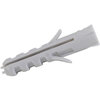Depending on the wall structure different methods may need to be employed.
If it's plasterboard dot & dab on a brick or block wall you need screws long enough to go into rawplugs in the brick/block work.
If the wall is lath and plaster then you need to screw into the upright studs. Not easy to fit those types of rails securely to slim upright studs even if you can find them.
I think the best method would be to mount a backboard securely into the brickwork or upright studs and then mount the handrails to the board.
Lets suppose it is lath and plaster. Draw a pencil line along the angle you want to mount the rails or use a chalk line, (Be careful to make both lines the same height and angle if you are fitting two opposite rails). This can be checked by tapping and if it sounds hollow you may also hear bits of plaster falling off inside the wall. You will notice a change in sound when you tap over the area of a stud. Make a small mark then measure approximately 16" (400mm) along to find the area of the next stud. Once the studs are roughly located you can dill pin holes along the angled line in the areas of the studs to give you the width of the stud. (Miss the sud, drill goes in very easily. Hit the stud and you feel resistance. Keep drilling every half inch until it goes easy again then go back an eighth of an inch until you hit the stud again.. This is the width of the stud. Draw short vertical lines each side of the stud so when you mount your backboard centrally along the angled line you will know where to screw it to. The hand rails can then be securely mounted to the backboard. To improve the look of the backboard you can chamfer each edge or round off the ends so they are a semi circle and then remove the sharp edges by rounding them off with sand/glass paper.
If the wall is brick/blockwork then, as above, screws long enough to grip into the brickwork. The backboard can also be used in this instance but it must be securely mounted to the brickwork first.






